Key takeaways:
- Latency affects system performance significantly and can disrupt workflows, highlighting the need for effective management strategies.
- Identifying and analyzing sources of latency, such as network congestion and software bugs, is essential for improving response times.
- Implementing optimization techniques like CDNs and edge computing can drastically enhance user experience by reducing loading times and improving data processing efficiency.
- Continuous monitoring and adjusting strategies based on performance metrics and user feedback are crucial for ongoing latency improvement and maintaining a favorable user experience.
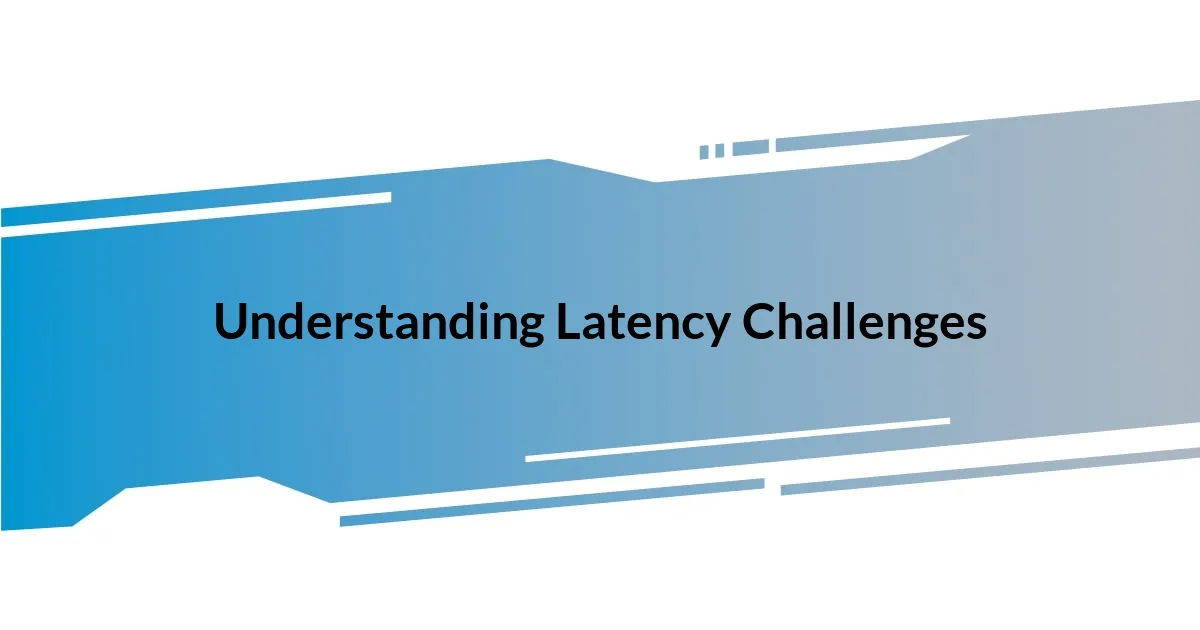
Understanding Latency Challenges
Latency can feel like an invisible chain, holding back the performance of our systems and, honestly, our patience. I remember the frustration I experienced during a crucial video conference when lag turned a five-minute update into a drawn-out ordeal. Isn’t it maddening when technology, which is supposed to enhance our communication, instead amplifies our sense of disconnect?
When we talk about latency, it’s important to grasp that it extends beyond mere response time; it can derail entire workflows. I’ve often wondered how many opportunities are lost because a tech delay caused a client to lose interest or an employee to drop a task in frustration. Each millisecond counts, and recognizing the broad impact of these delays encourages us to take action.
Different environments present unique latency challenges, and I’ve seen firsthand how varying internet speeds and server locations create barriers. Have you ever noticed how a simple game lags in peak hours? It’s a tangible reminder of how network congestion can turn seamless experiences into frustrating interruptions. Understanding these nuances is critical to developing effective strategies to combat latency.
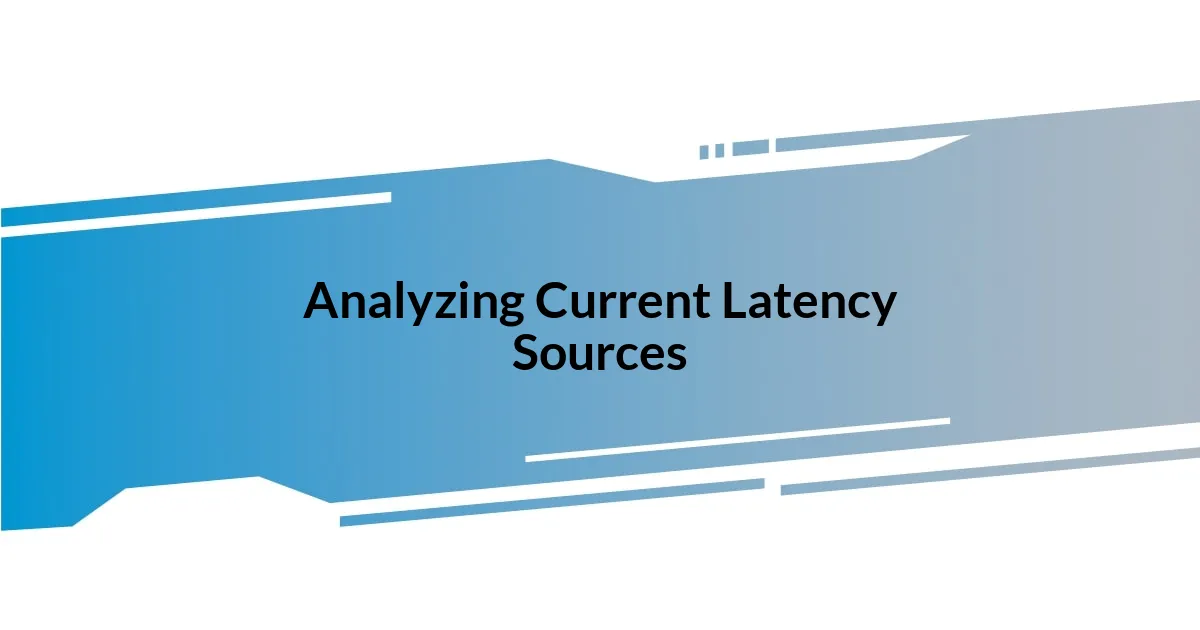
Analyzing Current Latency Sources
Analyzing the sources of latency can feel like peeling back the layers of an onion. I once spent an afternoon dissecting the performance of a web application that had been driving me up the wall. To my surprise, I found that the slowest aspect wasn’t the server response time but the heavy images that took ages to load. The experience really drove home the point that assessing every component, from user interface design to backend architecture, is crucial in identifying where delays creep in.
In my experience, network latency often stems from various factors like distance, congestion, and hardware limitations. I recall troubleshooting a virtual meeting where participants from different regions struggled to hear each other. It hit me that geographic distance combined with bandwidth limitations can exacerbate lag and make communication awkward. Evaluating these latency sources is not just about numbers; it’s about understanding how they impact real-time interactions.
I’ve also learned that software bugs can contribute significantly to latency issues. During a project, we encountered unexpected delays due to inefficient code that kept the application hung up. Analyzing our source code and optimizing its performance not only reduced latency but also improved user satisfaction. This hands-on experience reinforced the necessity of ongoing analysis, as even small changes can yield substantial results in latency reduction.
| Latency Source | Impact |
|---|---|
| Network Congestion | High – Causes slow data transfer |
| Server Location | Medium – Affects speed based on proximity |
| Hardware Limitations | High – Older devices cause slower processing |
| Software Bugs | Variable – Can lead to unexpected slowdowns |
| Heavy Media Files | Medium – Delays loading time if improperly optimized |
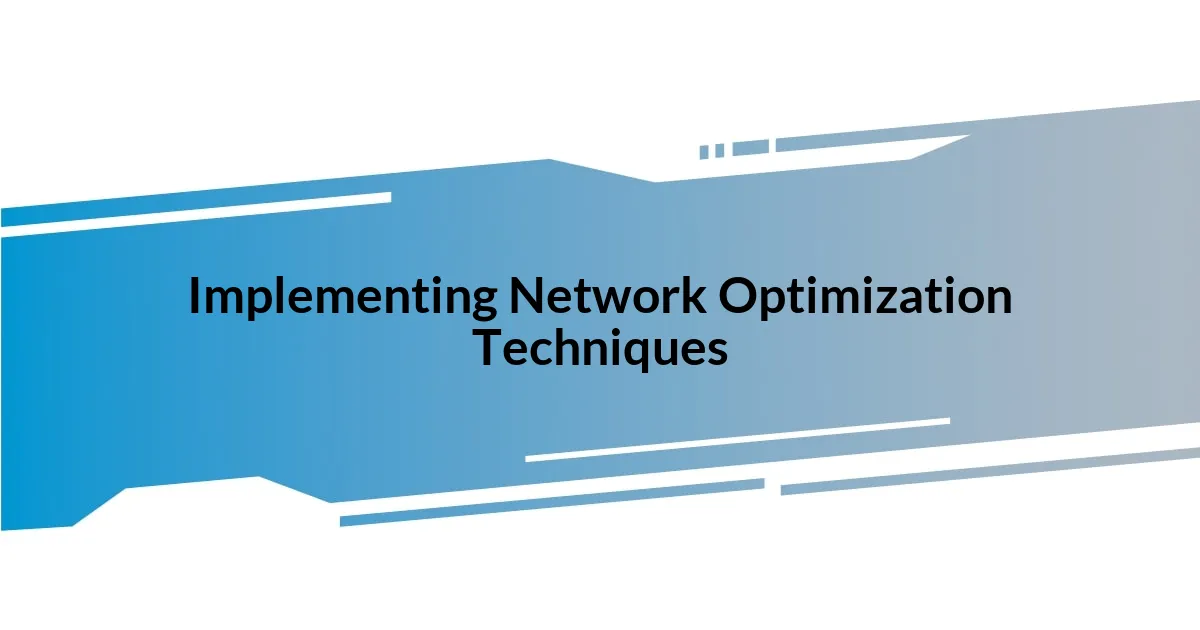
Implementing Network Optimization Techniques
Implementing network optimization techniques can truly feel like finding a treasure map — a discovery that can lead to smoother and faster digital experiences. I was once part of a team that revamped our content delivery network (CDN), which was like flipping a switch. Suddenly, users located far from our server were no longer frustrated by slow loading times, and the impact on user engagement was palpable. It’s remarkable how optimizing the pathways that data travels can make such a significant difference.
To enhance network performance effectively, here are some techniques I’ve found useful:
- Reduce Data Packets: Streamlining data can diminish transmission time, lowering latency.
- Utilize CDNs: They cache content closer to users, accelerating access speeds significantly.
- Prioritize Traffic: Implement Quality of Service (QoS) protocols to prioritize essential applications, ensuring they get the bandwidth they need.
- Optimize Routing: Adjusting the route that data takes can reduce the number of hops, which in turn minimizes delays.
- Regular Monitoring: Keeping an eye on network performance can help spot issues before they escalate, allowing for proactive measures.
When I think about the importance of implementing these techniques, I reflect back on a project where our team was grappling with frequent downtime. Our users were frustrated, and honestly, so were we. Implementing bandwith throttling really became a turning point. By regulating the traffic during peak usage times, we found that we not only maintained system stability but also significantly improved user satisfaction. This process reinforced my belief that optimizing our networks is not just about technology; it’s fundamentally about creating a positive experience for everyone involved.
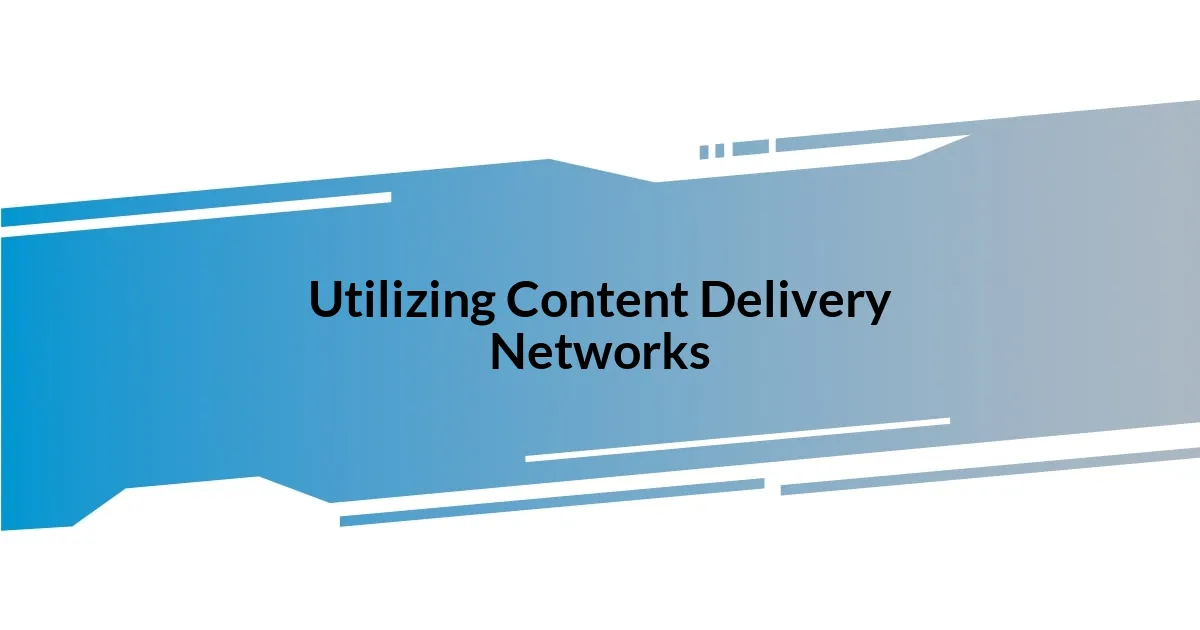
Utilizing Content Delivery Networks
Utilizing Content Delivery Networks (CDNs) is a game changer in the quest to reduce latency. I remember the moment we decided to implement a CDN for our application. The change was almost magical; users miles away from our servers reported loading times that felt instantaneous. It made me realize how putting content closer to users isn’t just a technical decision but an emotional one—people value their time, and we were respecting that.
One of the many benefits of CDNs that often gets overlooked is their ability to handle traffic spikes gracefully. During a promotional launch for our website, the influx of users threatened to crash our servers. But with the right CDN in place, the load was distributed smoothly. Have you ever prepared for a big event, where the anticipation builds but you just hope everything goes without a hitch? That’s exactly how I felt as I watched our site handle the traffic effortlessly. It’s a relief to know that technology can support us in those crucial moments.
Moreover, the ability of CDNs to serve cached content can significantly improve user experience. In a previous project, we had to deliver a series of instructional videos. Initially, the loading times were disheartening, often leaving users frustrated. Once we utilized a CDN, I could almost feel the shift in user sentiment; the videos streamed flawlessly, and it felt rewarding to witness our users engaging positively with the content. This experience underscored for me that when we invest in smart solutions like CDNs, we’re ultimately investing in trust and loyalty from our users.
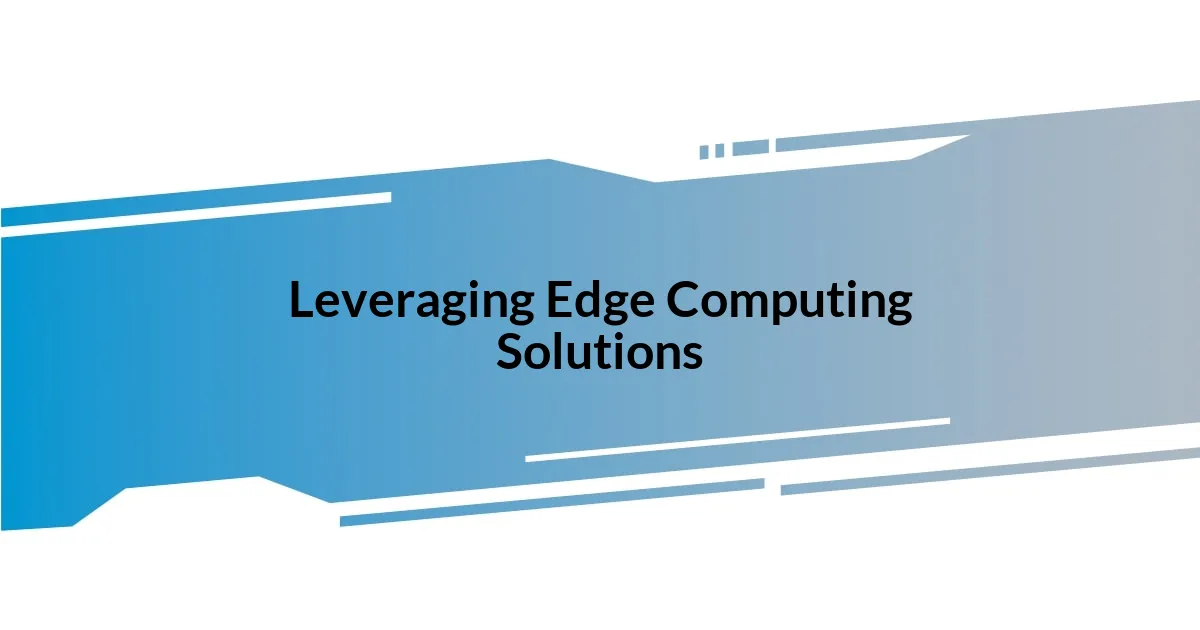
Leveraging Edge Computing Solutions
Leveraging edge computing solutions is like having a secret weapon in the battle against latency. I recall a time when our systems were underperforming due to the physical distance between our servers and users. Once we integrated edge computing, which essentially means processing data closer to the user rather than relying solely on distant servers, everything changed. It felt like turning on a light switch in a dark room; suddenly, data was being processed in real-time, and the drop in latency was evident.
Thinking about real-world applications, I remember collaborating on a smart city project. We deployed sensors throughout the area, and the data collected had to be analyzed quickly to respond to traffic changes. By utilizing edge computing, we could process that data on-site instead of sending it back to a central server for analysis, resulting in quicker decision-making. This experience reinforced my belief that when we bring computation closer to where the action happens, we empower real-time responses and enhance user experience significantly.
Have you ever noticed how a slight delay in a game can throw off your entire rhythm? Edge computing addresses this frustration by reducing lag times. I had a vivid moment while playing a multiplayer game where latency issues were ruining the fun. Post-implementation of edge solutions in our gaming platform, I experienced the game in a way I hadn’t before—smooth, responsive, and exhilarating. It truly highlighted for me that the benefits of edge computing go beyond just numbers; they touch on our daily experiences and interactions in a profound way.
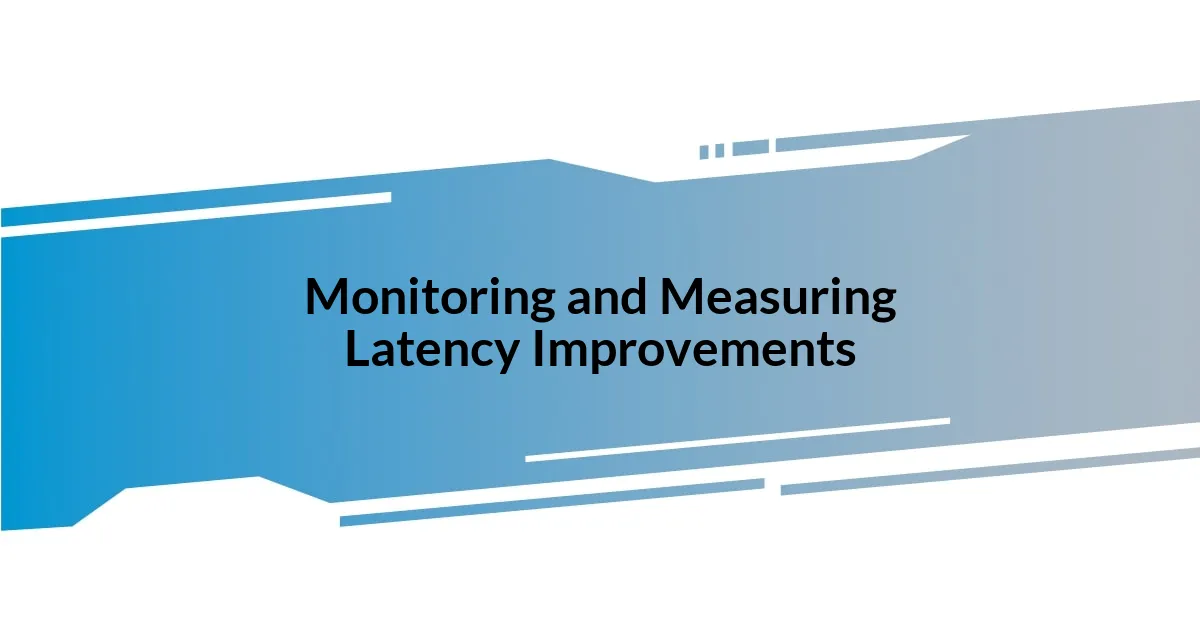
Monitoring and Measuring Latency Improvements
Monitoring latency improvements is essential to ensure that the strategies we implement are truly effective. I often set up performance monitoring tools that allow me to visualize latency in real-time. One time, I was troubleshooting a particularly slow API response, and it was eye-opening to see the metrics in action—like having an instant feedback loop that guided my next steps.
When measuring improvement, I focus on metrics such as Time to First Byte (TTFB) and round-trip time (RTT). I still remember the thrill I felt when we recorded a significant drop in TTFB after optimizing our backend processes. It was like running a race and finally breaking through that invisible barrier. This sense of achievement goes beyond statistics; it fuels my commitment to consistently refine our systems.
To connect these measurements with user experience, I take note of user feedback alongside the data. One project I worked on involved extensive A/B testing, correlating reduced latency with increased engagement. The more positive responses we received, the more convinced I became that monitoring isn’t just about numbers; it’s about delivering a smooth, enjoyable experience. Have you ever had that “aha” moment when feedback synchronizes perfectly with your findings? That’s where the magic truly lies.
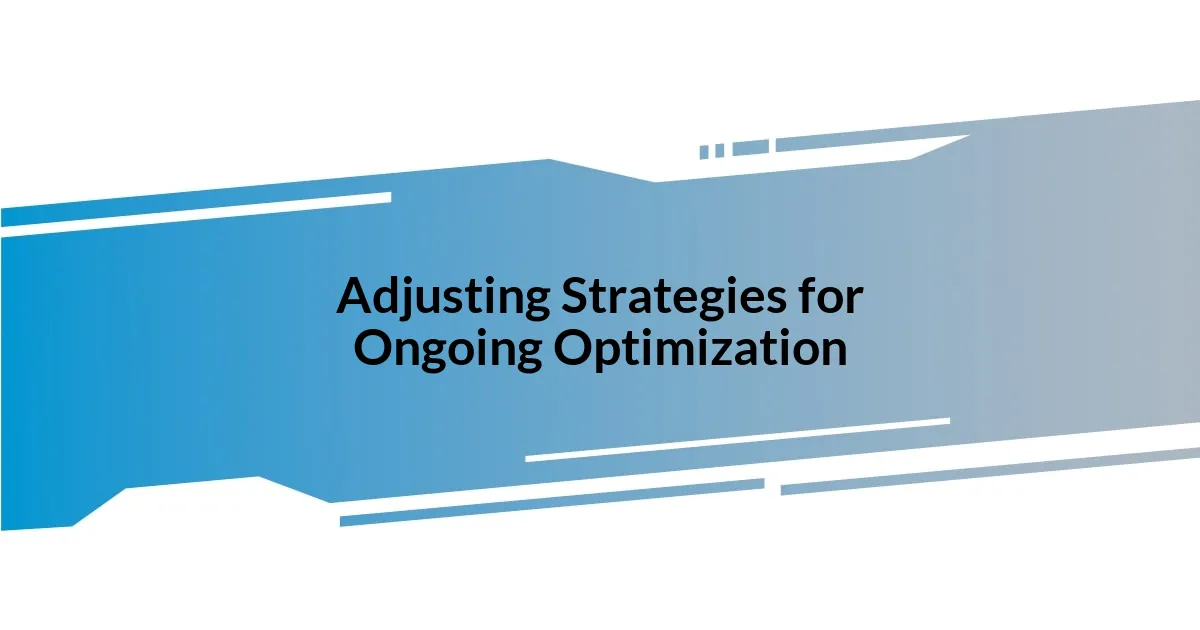
Adjusting Strategies for Ongoing Optimization
Adjusting strategies for ongoing optimization requires a commitment to adaptability and continuous learning. One of my memorable experiences involved revisiting the configuration of our server settings after noticing persistent latency. I took a deep dive into the documentation, and as I reconfigured these settings, I felt a mix of excitement and anxiety—would my adjustments make a difference? To my relief, they did! It was satisfying to witness latency improvements almost immediately, reaffirming the importance of regular strategy adjustments.
I’ve learned that keeping an eye on emerging technologies is vital for staying ahead. I recall a team brainstorming session where we discussed potential upgrades. It was exhilarating to realize that by integrating a new caching mechanism, we could reduce load times significantly. Have you ever felt that rush when a collective idea transforms into something actionable? The collaboration not only sparked creativity but also solidified our approach to continuously optimizing against latency.
Flexibility in strategy is just as crucial as the initial plan. I once faced a situation where a major software update inadvertently slowed our application. Instead of panic, we quickly assessed our processes and rolled back changes while collecting data to identify the root cause. It taught me that optimization isn’t just about implementation; it’s also about resilience and the willingness to pivot when necessary. Isn’t it empowering to know that even setbacks can lead to greater insights and ultimately better performance?